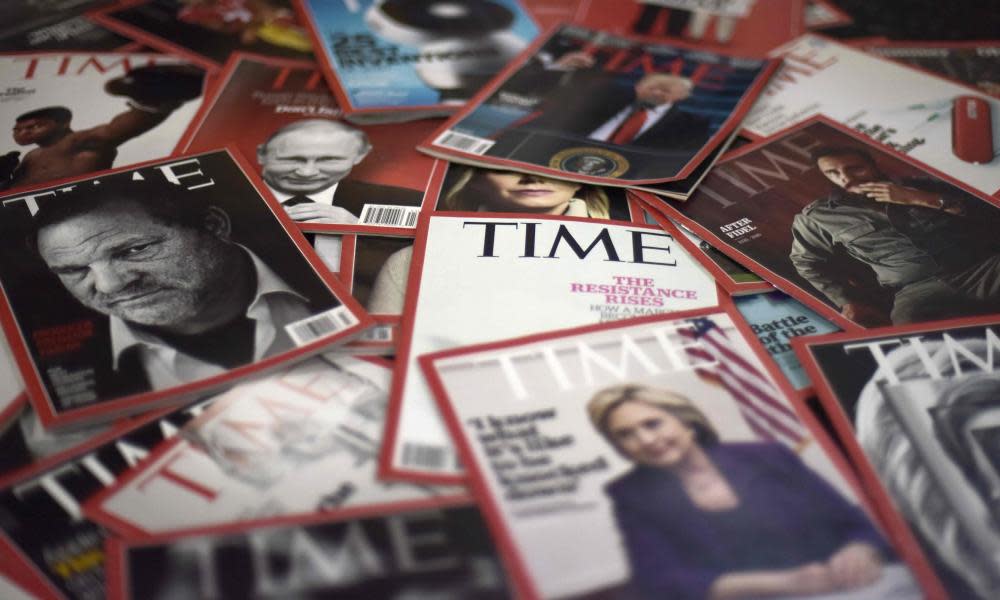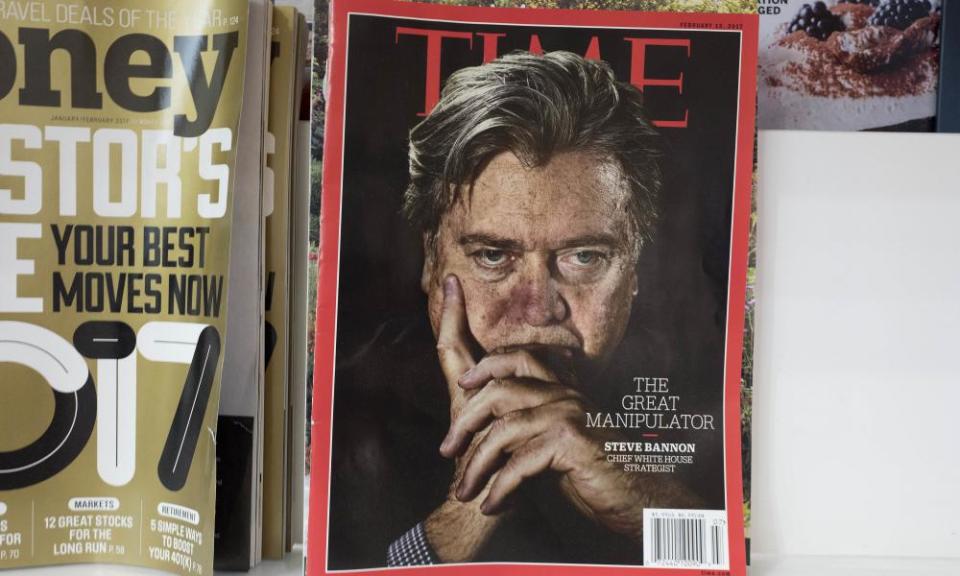Time: how the digital age became the iconic magazine’s unlikely savior

In February, Time magazine’s name was stripped from its headquarters in lower Manhattan. America’s most famous magazine seemed headed for the wastepaper bin of history, another victim of the digital age. Now, the digital age has come to save it.
Last week, Marc Benioff, the billionaire founder of software services company Salesforce, and his wife Lynne bought Time for $190m. The purchase came just one year after the 95-year-old news magazine had been acquired by Family Circle publisher Meredith as part of a package of titles of which Time looked like the unwanted stepchild.
There was applause in the office last Monday when the editor-in-chief, Edward Felsenthal, told staff about the sale. “We knew from the start – and Marc and Lynne said the same thing publicly – that this could be a really terrific fit,” Felsenthal told Columbia Journalism Review. But once the applause dies down, big questions remain to be answered. Is there really space for a weekly news magazine in an era where the world carries all the news it needs – with constantly pinging updates – on its phone? And is it really a good thing that tech’s billionaires are the new press barons?
Benioff joins a battery of tech billionaires who have recently made a bet on old media: Jeff Bezos owns the Washington Post; Laurene Powell Jobs, widow of Apple’s Steve Jobs, owns a majority stake in the Atlantic; Patrick Soon-Shiong, a surgeon and tech entrepreneur, owns the Los Angeles Times.
Do they see something the media – and Wall Street – don’t? Samir Husni, director of the Magazine Innovation Center at the University of Mississippi, and such an unapologetic fan of print that he’s know as “Mr Magazine”, thinks the answer is yes. “These people appreciate legacy media much more than the folks working in legacy media,” he said.
Time’s legacy helps mitigate against the idea of fake news
Samir Husni
Time still sells 2m copies a week and is profitable. Divorced from the pressures of being a small, unloved cog in a public company subject to the quarterly demands of Wall Street, Time can thrive, he said, not least because Time is a brand with authority in an era where authority is lacking. “Time’s legacy helps mitigate against the idea of fake news,” he said. “Time has a special place in the history of journalism.”
The magazine will need to offer depth and quality and be digitally savvy, said Husni, but the brand is well placed to survive the stormy seas now drowning many in the news media. And it’s still massive print run is also a major asset, he believes, not a burden. “No one can show me a publisher that has survived after abandoning its imprint edition,” he said.
Tech moguls can also bring something that the news industry desperately needs – new ideas, said Jeff Jarvis, who spent 10 years working at Time Inc and is now director of the Tow-Knight Center for Entrepreneurial Journalism.
Benioff’s Salesforce is expert in customer relationship management (CRM) software, something any news organization needs, and Bezos’s Amazon knows its customers in ways most media organizations can only dream of, he argues.
“These guys bring expertise that can really benefit the industry,” he said. “It’s not just about the money. It’s about new perspectives and new skills.”

But he’s not sold on Time’s long-term future as a weekly news magazine. “I used to buy magazines by the pound, they had to double-bag them. I never buy them now.” In a world where a reader in New York can get her news from the Guardian and a Berliner can read the New York Times, a weekly “homogenized” US news digest magazine is going to struggle no matter who has its back, said Jarvis.
Kyle Pope, Columbia Journalism Review’s editor and former editor-in-chief of the New York Observer and deputy editor of CondeNast Portfolio magazine, is even more circumspect. “Yes, it’s the golden age of the weekly print magazine,” he joked.
“I think there is space for Time,” he says. “In this climate there are a handful of titles that are safe, iconic brands. I think what you are seeing is that there is a supply of very wealthy people who see value in attaching their names to these brands, and I think that’s why they are going to survive. Is there a reason to look at this and be hopeful about the business model of journalism? The short answer to that is no.”
There’s something off about journalists celebrating bailouts by super-rich saviours, said Pope. The idea that “journalists who are supposed to love taking on the man” are so happy to take their cash is “erm, somewhat amusing”, he said.
The current environment hearkens back to the days of press barons like William Randolph Hearst, the son of a millionaire mining magnate who built the US’s largest newspaper chain, or Rupert Murdoch, who both used their publications to push their own agendas.
So far the new plutocrats have – in the main – been good owners. Bezos has invested heavily in the Washington Post and seems to have kept his promise of keeping out of the paper’s editorial decisions. “But one can easily imagine a scenario where that doesn’t go so well,” he said. “With all of these people you can imagine scenarios where their business interests clash with their editorial ones and it gets ugly.”
There have already been recent examples of rich men tiring of their new toys and the pressures of running a media company. Last year Joe Ricketts, the billionaire founder of TD Ameritrade, shut down Gothamist and DNAinfo after its writers voted to unionize. Peter Barbey, heir to the VF Corporation retail empire, owner of Vans, Timberland, North Face and other brands, recently shut down the Village Voice after killing its print edition.
In another era this trend of super rich buying media icons would be something people would be very wary of, said Pope. “I think it says something about the state of the business of journalism that it is the only hope we have got,” said Pope.

 Yahoo News
Yahoo News 
